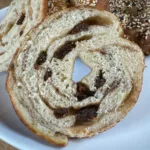
New York Bagel Recipe
This is my take on an old New York style bagel recipe by Peter Reinhart.
Servings 10 bagels
Cost 5
Ingredients
Dough
- 3 ½ cups bread flour or high gluten bread flour (Artisan) (454 grams)
- 1 teaspoon diastatic malt powder if using a bread flour that doesn't include barley malt. This is optional!
- 1 teaspoon instant yeast
- 1 ½ teaspoons salt
- 1 ½ tablespoons honey (40 grams)
- 1 cup plus 2 tablespoons warm water
Poaching liquid (see note)
- 2 to 3 quarts water
- 1 ½ tablespoons honey
- 1 tablespoon baking soda
- 1 teaspoon salt
Cinnamon Raisin Variation (Optional)
- 1 teaspoon brown sugar
- ¼ teaspoon cinnamon
- ⅓ cup raisins (just an estimate, use as many as you like)
Instructions
- Weigh your flour and put it in the bowl of a stand mixer. Stir in the malt powder (if using), yeast and salt. Pour honey on top, then add water and stir with a big spoon or rubber scraper until blended.
- Set your bowl under the mixer with the dough hook attached, and knead with the dough hook for 3 to 5 minutes or until the ball is sturdy, smooth and elastic.
- Remove the dough from the bowl. Wipe bowl clean and rub it with a tiny amount of olive oil, then put the ball of dough back in the bowl and rotate it so that it’s very lightly coated with oil. Cover bowl and let dough rise for 45 minutes to an hour
- This recipe makes about 25 oz of dough, so you can base the size on that. For smaller bagels, make each a little over 3 oz each (8 bagels) or for large bagels make them 4 oz each (6). If you want to make the cinnamon raisin variation, skip down to the bottom.
- Line two baking pans with parchment and oil the parchment. Oil keeps the dough from sticking to the parchment and deflating when you pull it off to boil. Do not use coconut oil because it will set in the refrigerator and stick. Just use regular olive or vegetable oil. Chill overnight for 12 to 18 hours.
Day 2
- Remove the bagels from the refrigerator and let sit at room temperature for up to 20 minutes while you preheat the oven and get the boiling water solution going.
- Preheat the oven to 450 degrees F. Bring 2-3 quarts of water to a boil. Line a heavy duty baking sheet with parchment paper. You should not need to grease it this time.
- When water is boiling, carefully add the baking soda, syrup and salt – be careful and stand back because it may boil up. Drop 2 or 3 bagel dough rounds into the boiling water and boil for 30 seconds. Turn and boil other side sfor 30 seconds. Lift boiled bagels carefully with a spatula, letting water drip back into the pan. Place boiled bagels on a rack to let more water drain off, then brush with egg white (if using) and add toppings (if using). Transfer to a baking sheet. Parchment paper is okay for protecting the sheet, but not required.
- Put the bagels in the oven on center rack. Bake at 450 for about 20 minutes.
- Let the bagels cool down for at least 30 minutes before eating.
For Cinnamon Raisin Variation
- On day 1 when you are forming your bagels, take one section of dough and press it into a rectangle approximately 4x3 ½ inches. Also, you really shouldn’t need to flour your surface. Dough should be so smooth and pliable that you can just pat it out onto a clean surface such as a plastic cutting board or parchment lined counter. If it’s really sticky for some reason, you could try rubbing a little oil on it.
- Sprinkle a packed teaspoon of dark brown sugar onto your little rectangle. Sprinkle as much cinnamon as you like over that, then sprinkle raisins – as many as you want, over the cinnamon. Now roll the rectangle lengthwise into a little tube as if you were making cinnamon rolls. Squeeze the tube and elongate it until it’s about 8 inches, then bring the ends together to make your bagel ring. Set on the oiled parchment in one of the pans and repeat to make as many cinnamon bagels as you want.
- If you want, you can sprinkle the boiled bagels with a little cinnamon sugar. If you are making plain or topped bagels, top with whatever topping you are using.
Notes
This recipe calls for diastatic malt powder, not non-diastatic. The two are different. In this recipe, the diastatic malt powder is used in a small amount to keep the yeast alive and healthy during its overnight stint in the refrigerator. For recipes that do not require a long rise in the refrigerator, you would use non-diastatic malt powder, which aids in color and flavor but does not have the active enzymes to feed the yeast during the extended rise.
Another thing I've learned is that if you use a brand like Bob's Red Mill artisan flour, you can skip the diastatic malt powder because the flour blend already has an enzyme to improve performance.